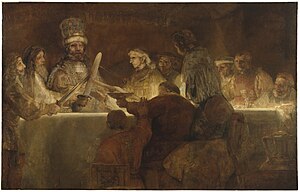| Revolt of the Batavi | |||||||
|---|---|---|---|---|---|---|---|
| Part of the Year of the Four Emperors | |||||||
 The Conspiracy of Claudius Civilis, completed by Rembrandt in 1661 | |||||||
| |||||||
| Belligerents | |||||||
|
Batavi Cananefates Frisii Lingones Treveri |
| ||||||
| Commanders and leaders | |||||||
|
Gaius Julius Civilis Brinno Julius Tutor Julius Classicus Veleda |
Marcus Hordeonius Flaccus Claudius Labeo Munius Lupercus Quintus Petillius Cerialis | ||||||
| Strength | |||||||
|
Depending on definition of loyalty: |
Initially: | ||||||
| Casualties and losses | |||||||
| Relatively light | 10,000–20,000+ | ||||||
The Revolt of the Batavi took place in the Roman province of Germania Inferior ("Lower Germania") between AD 69 and 70. It was an uprising against the Roman Empire started by the Batavi, a small but militarily powerful Germanic tribe that inhabited Batavia, on the delta of the river Rhine. They were soon joined by the Celtic tribes from Gallia Belgica and some Germanic tribes.
Under the leadership of their hereditary prince Gaius Julius Civilis, an auxiliary officer in the Imperial Roman army, the Batavi and their allies managed to inflict a series of humiliating defeats on the Roman army, including the destruction of two legions. After these initial successes, a massive Roman army led by the Roman general Quintus Petillius Cerialis eventually defeated the rebels. Following peace talks, the Batavi submitted again to Roman rule, but were forced to accept humiliating terms and a legion stationed permanently on their territory, at Noviomagus (modern day Nijmegen, The Netherlands).